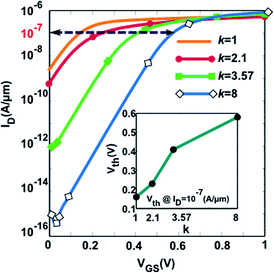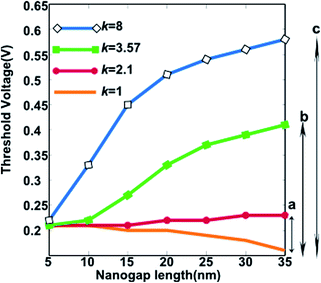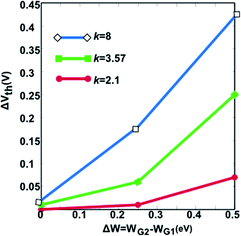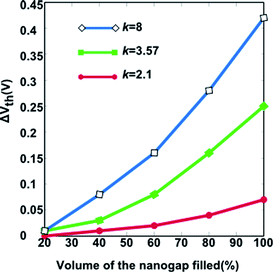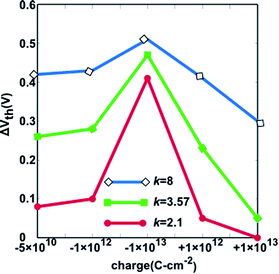Performance assessment of dual material gate dielectric modulated nanowire junctionless MOSFET for ultrasensitive detection of biomolecules
Zahra Ahangari
Young Researchers and Elite Club, Yadegar-e-Imam Khomeini (RAH) Shahre Rey Branch, Islamic Azad University, Tehran, Iran. E-mail: z.ahangari@iausr.ac.ir; z.ahangari@gmail.com
First published on 13th September 2016
Abstract
In this paper, the potential capability of a novel dielectric modulated dual material gate nanowire junctionless MOSFET as a promising biosensor is demonstrated. The impact of the structural parameters on the sensitivity of the proposed device is thoroughly implemented for designing a low power, highly responsive biosensor. A nanogap is embedded in the gate insulator region for immobilizing the biomolecules. Accumulation of biomolecules in the nanogap changes the gate capacitance and results in threshold voltage deviation. The sensitivity of the biosensor can be improved for a wide range of biomolecules by adjusting the gate workfunction difference over the nanogap region and the remnant part of the channel. An optimum value of 0.5 eV difference is achieved. It is shown that by considering maximum length for the nanogap beside occupation of the whole volume of the cavity, a maximum degree of sensitivity for the biosensor can be achieved. In addition, there exists a tradeoff between the off-state current and sensitivity of the biosensor. Consequently, an optimum value of (3–5) × 1018 cm−3 is attained for the doping concentration. Moreover, absorption of negatively and positively charged biomolecules on the sensitivity of the sensor is discussed extensively. The results in this paper pave the way for integrating biodetection techniques with the existing CMOS technology.
Introduction
Recently, developments in semiconductor technology are progressively pushing the dimensions of MOSFETs towards the nanoscale regime in order to provide high-speed integrated circuits with high-packing density. However, the influence of short channel effects seriously affects the device performance in ultra scaled structures. The charge sharing from the depletion layers of the source/channel and drain/channel PN junctions reduces the gate controllability over the channel. In order to degrade short channel effects, multi-gate structures such as double-gate, FinFETs and surrounding-gate nanowires are proposed as candidates that can improve the gate control over the channel.1,2The applications of 1-D silicon nanowire field effect transistors (FETs) as a real-time, label-free and highly sensitive biosensor have recently gain enormous attention.3–5 The absorption of biomolecules in 2-D planar FETs merely changes the surface carrier concentration of semiconducting channel. Since the diameter of 1-D nanostructures is comparable to the size of biomolecules and due to better gate controllability over the channel, the carrier concentration of the whole volume of nanowire is affected by biomolecules. In ref. 6, a dual-gate silicon nanowire MOSFET fabricated on a bulk substrate is designed for label-free electrical detection of the avian influenza antibody. In the proposed biosensor, the channel potential of the nanowire FET is influenced by the polarity and charge of the biological molecules that binds to the part of the channel that is not covered by the gate electrode. Nanowire tunnel field effect transistor based biosensor is proposed in ref. 7, and it is shown that this device can revolutionize the biosensing applications. Different current mechanism in this device in the form of band to band tunnelling provides higher sensitivity than the conventional MOSFET. Absorption of biomolecules in the gate region modifies the gate voltage and hence the tunnelling current.
In a conventional inversion mode MOSFET, the current flows along the channel when the gate voltage exceeds a typical value known as the threshold voltage, abbreviated as Vth. The threshold voltage mainly depends upon the gate capacitance which can be modulated by the dielectric constant of the insulator below the gate electrode. Dielectric-modulated FET based on conventional MOSFET is demonstrated as a powerful approach towards the detection of biomolecules. Im et al. have experimentally demonstrated the feasibility of a nanogap-embedded FET biosensor via detection of specific binding of streptavidin to biotin.8 In this structure, a nano cavity is embedded in the gate insulator region or at the side gate electrode for immobilizing the biomolecules. The binding of the streptavidin alters the gate capacitance and converts the absorption of biomolecules into useful changes in the electrical characteristics. The absorbed biomolecule changes the dielectric constant (k) of the nano cavity and as a consequence, modifies the threshold voltage of the device. For improvement of the nanogap filling via fluidic materials such as antigen–antibody binding or with water molecules (as humidity sensor), and hence possible increment of sensitivity, a novel dielectric modulated nanowire FET consists of two-side opened walls is demonstrated in ref. 9. The numerical simulations verified by ATLAS simulator10 and the experimental results show a good agreement. In ref. 11, a double gate asymmetric dielectric modulated silicon nanowire MOSFET is proposed, experimentally. The air-filled nanogap is embedded between the bottom gate and the silicon nanowire in which targeted biomolecules are immobilized. The proposed technique is able to extract the dielectric constant and charge density of biomolecules electrically without the need of complicated measurement systems. The dielectric modulated FET has the potential to be extended for various types of FETs such as impact ionization MOSFET (IMOS),12,13 tunnel FET,14,15 junctionless MOSFET and double gate FET structure.16 Yet, fabrication of ultimately scaled highly doped source/drain regions with ultra sharp profile at the channel interface is still a great challenge for production of multi-gate MOSFET structures as biosensor. Junctionless MOSFET (also called a gated resistor) resembles the conventional MOSFET in structure and is proposed as a candidate that can overcome this problem.17–20 Unlike the conventional inversion-mode MOSFET, junctionless MOSFET has no PN junction and no doping concentration gradients at the source/drain conducting channel interface. The N-channel junctionless MOSFET has N–N–N type doping profile while the P-channel device has P–P–P type doing for the source, channel and drain, respectively. Since there exists no doping concentration variation in this device, the fabrication process is simplified considerably and the required thermal budget is reduced as no diffusion of impurities is needed. The operation of junctionless MOSFET is based on the depletion or accumulation of the carriers in the channel. In conventional MOSFET, the gate electrode modulates the carrier concentration in the surface of the channel, where as in junctionless MOSFET, the gate voltage modifies the carrier concentration in the bulk of channel. The important point in design and fabrication of a junctionless MOSFET is the formation of a thin and narrow semiconductor layer that can be fully depleted by the gate and channel workfunction difference in the off-state mode of operation. On the other hand, heavily doped source, drain and channel regions are required to allow considerable amount of current flow in the on-state regime.
In this paper, the advantages of both 1-D nanowire structure and junctionless MOSFET are considered for designing an exceedingly responsive biosensor. The threshold voltage of the device can be easily modulated by changing different structural parameters such as the gate dielectric constant, doping concentration, channel length and gate workfunction making this device an interesting candidate for nanowire FET biosensor devices. The main objective of this paper is to investigate the electrical properties of a novel dual material gate dielectric modulated nanowire junctionless MOSFET (DMNJFET) and further try to optimize its structural parameters for use as a highly sensitive low power biosensor. The proposed dual material gate structure is capable of efficient detection and dissociation of different biomolecules. The paper is organized as follows: the proposed nanowire sensor and the simulation method are presented in section two. Next, the operation of biosensor and impact of structural parameters on the sensitivity of the device are discussed extensively. The paper is summarized in section four.
Device structure and simulation method
The schematic of the dielectric modulated nanowire junctionless MOSFET is illustrated in Fig. 1. The main difference between a dielectric modulated junctionless MOSFET and a conventional nanowire junctionless MOSFET involves the embedded nanogap at the edge of the gate dielectric at which biomolecules are accumulated. The structure is dual material gate where the gate workfunction over the nanogap region differs from the metal gate over the remnant part of the channel. Furthermore, absorption of different biomolecules is modeled by inserting insulators with dielectric constant similar to the individual biomolecule in the nano cavity. Air-filled cavity is modeled by employing an insulator with (k = 1). The biomolecules which are considered in this study are streptavidin (k = 2.1), 3-aminopropyltriethoxysilane (APTES) (k = 3.57) and protein (k = 8).21 The size of biomolecules is reported within deca nanometer for protein and nearly 5 nm for streptavidin.22 As a result, the vertical length of 10 nm for the nanogap seems acceptable. Additionally, the trapping of streptavidin within 10 nm cavity is verified experimentally by Kim et al.23 The structural parameters of the nanowire junctionless MOSFET that are used in this study are shown in Table 1. Simulations are performed by numerical device simulator.10 Furthermore, carrier velocity saturation, SHR (Shockley Read Hall), carrier–carrier scattering in the highly doped structure, dependence of carrier mobility on temperature and vertical electric field are the models which are taken into account in this study.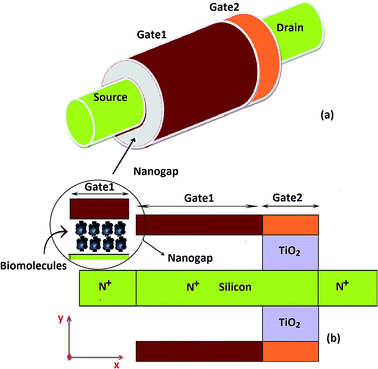 | ||
| Fig. 1 (a) The 3-D schematic of dual material gate nanowire junctionless MOSFET. (b) Cross section of the simulated device along the x-axis. A nanogap is embedded in the gate insulator region. | ||
| Device parameter | Value |
|---|---|
| Gate1 workfunction (WG1) | 4, 4.25, 4.5, 4.75 and 5 eV |
| Gate2 workfunction (WG2) | 5 eV |
| Channel length | 40 nm |
| Nanogap length (Lgap) over gate1 | Varies from 5 nm to 35 nm |
| Channel length over gate2 | Varies from 35 nm to 5 nm |
| S/D and channel doping | Varies from 1 × 1018 cm−3 to 1 × 1019 cm−3 |
| Gate insulator thickness (tins) | 10 nm |
| Nanogap thickness | 10 nm |
| Nanowire diameter | 3 nm |
| Relative permittivity of the insulator over gate2 | 50 (TiO2) |
| Drain voltage (VDS) | 50 mV |
Impact of structural parameters on the responsivity of nano biosensor: results and discussion
This section presents the results of the simulated DMNJFET as a nano biosensor. The impact of structural parameters and design considerations on the sensitivity of biosensor are discussed extensively. For an NMOS operation and in the off-state mode, the gate-channel workfunction difference depletes the electrons from channel and blocks the current flow. The repelled electrons form wide depletion layer along the channel thickness mainly beneath the gates. As a positive gate voltage is applied, the depletion layer width is reduced and carriers move along the conducting channel. Fig. 2 shows a schematic of DMNJFET when the biomolecules are immobilized in the partial volume of the nano gap and the remnant part of the gap is air filled. A simplified capacitance model for DMNJFET is shown for illustrating the bio-sensing action, as well. One distinguished feature of the proposed structure is its asymmetric dielectric layer beneath the gate. The dielectric layer between gate1 and the channel is composed of an air gap in which targeted biomolecules are accumulated. In case of absorption of biomolecules, the dielectric constant of the nanogap increases from air (k = 1) to the related value of each individual biomolecules. In contrast, the gate dielectric between gate2 and the channel is composed of 10 nm TiO2. The capacitance of gate1 consists of a series combination of the capacitance of the air-filled part of the nanogap, Cair, the capacitance of biomolecules, Cbio, and Cdep that denotes the depletion capacitance of channel. The capacitance of gate2 consists of the gate insulator capacitance, Cins, and the depletion capacitance in series.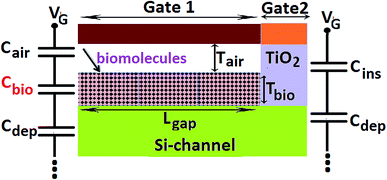 | ||
| Fig. 2 A schematic of DMNJFET when the biomolecules are accumulated in the nanogap and a simplified capacitance model of gate1 and gate2. | ||
The effective gate1 capacitance, CG1, of the proposed DMNJFET can be given by:
 | (1) |
The nanogap capacitance, Cnanogap, is denoted as:
 | (2) |
 | (3) |
Thus, the larger is the absolute value of ΔVth, the better is the sensitivity of the biosensor. In case of accumulation of biomolecules in the cavity, the threshold voltage shifts towards higher gate voltages. The inset of Fig. 3 demonstrates the threshold voltage before and after absorption of various types of biomolecules.
Next, impact of nanogap length on the threshold voltage of DMNJFET is thoroughly addressed. The results are illustrated in Fig. 4. The gate workfunction over the nanogap (gate1) and gate2 are 4.5 eV and 5 eV, respectively. The source, drain and channel doping concentration are 5 × 1018 cm−3 and the drain voltage is 50 mV. A uniform dielectric constant indicating a specific biomolecule is assumed inside the 100% volume of the cavity. The length of nanogap over the channel (Lgap) is controlled by varying the duration of lateral etching of TiO2. Before the absorption of biomolecules, the threshold voltage degrades from 0.21 V for Lgap = 5 nm to 0.16 V for Lgap = 35 nm. As expected, with a longer cavity length, the air-filled cavity (k = 1) reduces the gate capacitance and eventually declines the gate controllability over the channel. In this situation, the channel cannot be fully depleted and results in the decrement of the threshold voltage. After the absorption of biomolecules that modifies the electrostatic coupling between the channel and gate, the increment of cavity length results in the threshold voltage enhancement in comparison with the air-filled nanogap. As implied earlier, absorption of biomolecules with k > 1, increases the gate capacitance over the channel. As illustrated in Fig. 4, the maximum threshold voltage deviation after the absorption of biomolecules (in comparison with the air-filled cavity) for Lgap = 35 nm is calculated as follows: ΔVth (a) = 0.07 V, ΔVth (b) = 0.25 V and ΔVth (c) = 0.42 V for biomolecules with k = 2.1, k = 3.57 and k = 8, respectively. The important point in designing a dielectric modulated MOSFET is the dominancy of the absorbed biomolecules for modulating the threshold voltage. In case of accumulation of low-k biomolecules in device with short nanogap length, there exists weak gate to channel coupling via the nanogap as the gate capacitance mostly pertains to TiO2. It is worth to mention that for improving the responsivity of the biosensor for biomolecules with low dielectric constant, the cavity length should be extended. Moreover, accumulation of high-k biomolecules results in greater gate controllability over the channel and clearly indicates that the cavity length does not have to be as large as possible.
The main objective of this paper is to design a low power biosensor with superior sensitivity. The influence of different workfunction configuration on the sensitivity and power consumption of biosensor is taken into account. For the fixed length of nanogap, Lgap = 35 nm, the effect of workfunction difference between gate1 and gate2 (ΔW = WG2 − WG1) on the performance of DMNJFET is analyzed. The doping concentrations of source, drain and channel are 5 × 1018 cm−3. The off-state current, Ioff, is calculated before the absorption of biomolecules while WG1 varies from 4 eV to 5 eV and WG2 is fixed at 5 eV. The low workfunction gate over the air-filled nanogap degrades the gate ability to deplete the channel.
Accordingly, the highly doped channel provides high off-state current and consequently increases the static power consumption of the device. Obviously, as illustrated in Fig. 5, Ioff is enhanced as the workfunction of gate1 approaches to 4 eV and the workfunction difference (ΔW) is increased to 1. The off-state current for WG1 = 5 eV and WG2 = 5 eV (ΔW = 0 eV) is nearly 8 × 10−17 (A μm−1) and enhances to 10−7 (A μm−1) for WG1 = 4 eV and WG2 = 5 eV (ΔW = 1 eV). As implied in Fig. 5, the dual material gate configuration with WG1 = 4.5 eV and WG2 = 5 eV = 5 eV (ΔW = 0.5 eV) provides low off-state current of 10−9 (A μm−1). The increment of workfunction difference between gate1 and gate2 above 0.5 eV, results in considerable enhancement of off-state current. As a result, the gates workfunction difference is particularly limited from zero to 0.5 eV for achieving a device with low off-state current. The sensitivity (ΔVth) of the biosensor is calculated as a function of workfunction difference after the absorption of various biomolecules, Fig. 6. Simulation results reveal that as ΔW approaches to 0.5 eV, the sensitivity of biosensor is improved considerably. Therefore, after all tradeoffs, an optimum value of ΔW = 0.5 eV is suggested for the DMNJFET as a low power FET sensor which allows an opportunity to enhance the detection sensitivity.
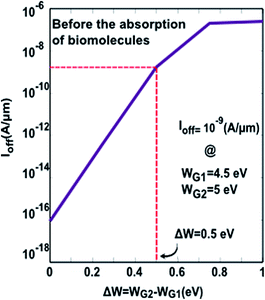 | ||
| Fig. 5 The off-state current versus the workfunction difference between gate1 and gate2. The gate2 workfunction is fixed at 5 eV. | ||
The influence of source, drain and channel doping on the sensitivity metric, ΔVth, of the DMNJFET is thoroughly elaborated. The main objective of doping concentration variation is determining the optimum value that may result in the improvement of biosensor responsivity with low power consumption. The nanogap length (Lgap) is 35 nm and the workfunction difference between gate1 and gate2 is 0.5 eV. The doping concentration varies from 1 × 1018 cm−3 to 1 × 1019 cm−3. The threshold voltage deviation after the absorption of biomolecules as a function of doping concentration is illustrated in Fig. 7. The threshold voltage of DMNJFET can be modulated by both the doping concentration and absorption of biomolecules that modifies the gate capacitance. The low doped channel (1 × 1018 cm−3) makes the channel deplete more effectively and increases threshold voltage of the device even before the absorption of biomolecules. In other word, due to the increment of depletion layer width along the channel, the DMNJFET has minor responsivity (ΔVth) for low doped channel even for high-k biomolecules. As a consequence, dissociation of different biomolecules and sensitivity of the biosensor are drastically declined. As the channel doping increases to 3 × 1018 cm−3, sensitivity of the sensor is improved considerably. Slight increment of the channel doping makes the role of absorbed biomolecules on the threshold voltage variation more outstanding. Further increment of doping concentration to 5 × 1018 cm−3 degrades the sensitivity of sensor for low-k biomolecules but on the other hand, increases the segregation potency of the biosensor for diverse biomolecules. In case of highly doped DMNJFET and before the absorption of biomolecules, the depletion layer width near the top and bottom gate is decreased considerably which makes the channel more difficult to be fully depleted. Accordingly, the off-state current and consequently the static power consumption are enhanced. The threshold voltage decreases from 0.57 V to 0.07 V for doping concentration of 1 × 1018 cm−3 and 1 × 1019 cm−3, respectively. Evidently, in case of heavily doped structure and after the accumulation of biomolecules, the role of doping concentration is more dominant on threshold voltage deviation than the role of absorbed biomolecules. In this situation, the biosensor merely has an acceptable sensitivity for high-k biomolecules and low-k biomolecules cannot modify the threshold voltage. The results prove that for designing a low power sensitive biosensor, doping concentration plays a major role and determining an optimum value of doping concentration is beneficial and necessary. As a consequence, an optimum value of (3–5) × 1018 cm−3 seems favourable.
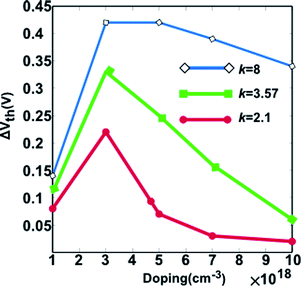 | ||
| Fig. 7 The threshold voltage variation after the absorption of biomolecules versus the doping concentration. The optimum gate workfunction difference between gate1 and gate2 is fixed at 0.5 eV. | ||
It is critical to analyze the sensitivity of the DMNJFET upon the percentage of nanogap volume filled by biomolecules in vertical direction. The nanogap length (Lgap) is 35 nm and the optimum value of 0.5 eV workfunction difference between the gates is employed. The results are depicted in Fig. 8. The threshold voltage shift (ΔVth) or in other words, the sensitivity of biosensor for three different types of biomolecules is increased as the occupancy of nanogap in vertical direction is enhanced. The higher percentage of the immobilized biomolecules in the nanogap increases the dominant role of absorbed biomolecules on CG1 and consequently improves the gate control over the channel. Complete occupancy of the nanogap is essential for low-k biomolecules whereas semi-filled cavity provides considerable sensitivity for high-k biomolecules. Maximum sensitivity of the biosensor is 0.07 V, 0.25 V and 0.42 V threshold voltage deviations for biomolecules with dielectric constants of 2.1, 3.57 and 8, respectively.
It is critical to elucidate the impact of surface charge of biomolecules on the sensitivity of biosensor. The charge of biomolecules depends upon the pH of solution, molar concentration of the molecules and their related isoelectric point. The isoelectric point is the specific pH at which a particular molecule carries no net electrical charge and is neutral. The variance between the isoelectric point and pH of solution determines the charge configuration of biomolecules. Biomolecules have positive surface charge if pH < isoelectric point and negative surface charge if pH > isoelectric point.16 The effect of absorption of both positive and negative surface charge biomolecules on threshold voltage deviation of DMNJFET is investigated and the results are presented in Fig. 9. The negative charges vary from −5 × 1010 (C cm−2) to −1 × 1013 (C cm−2) and the positive charges range from +1 × 1012 (C cm−2) to +1 × 1013 (C cm−2).
Negative charge beside the dielectric constant of individual biomolecules can modify the channel potential and consequently modulate the threshold voltage of DMNJFET. Negative charges repel electrons from the surface of the channel and strengthen the depletion of the channel. The role of negative surface charge competes with the dielectric constant of the biomolecules. In case of absorption of biomolecules with negative surface charge ranging from −5 × 1010 (C cm−2) to −1 × 1012 (C cm−2), the role of the dielectric constant of biomolecule on modulating the threshold voltage is dominant. The threshold voltage variations are ΔVth = 0.1 V, ΔVth = 0.28 V and ΔVth = 0.43 V for k = 2.1, k = 3.57 and k = 8, respectively. As the negative charge density increases to about −1 × 1013 (C cm−2), the role of negative charge density on ΔVth prevails over the dielectric constant of the absorbed biomolecule. The possible disadvantageous of this condition is that the distinguishability of DMNJFET for various types of biomolecules from each other is significantly degraded. In order to make certain effective detection of different biomolecules, it is suggested to adjust the charge of biomolecules near −1 × 1012 (C cm−2).
On the contrary, the absorption of positively charged biomolecules declines the sensitivity of the biosensor. Positive surface charges reduce the depletion layer width inside the channel and diminish the gate control over the channel, especially for low-k biomolecules. The biosensor provides efficient responsivity for biomolecules with high dielectric constant. High-k biomolecules improve the gate controllability over the channel and diminish the side effect of positive charges.
Conclusions
The electrical characteristics of dual material gate dielectric modulated nanowire junctionless MOSFET as a highly sensitive low power biosensor are thoroughly investigated. The proposed dual material structure with optimum value of 0.5 eV difference between the workfunction of gate over the nanogap and the gate over the remnant part of the channel improves the sensitivity of biosensor. Moreover, considering maximum length for the fully occupied nanogap boosts the sensitivity of biosensor even for low-k biomolecules. Simulation results reveal that for obtaining a desirable value of responsivity for the biosensor, an optimum value of doing concentration is required. In addition, for improving the biosensor performance, it is suggested to adjust the negative charge of biomolecules near −1 × 1012 (C cm−2). It is expected that the proposed device is fully compatible with CMOS technology and can be efficient and practical for biosensor applications.Acknowledgements
The financial support of Young Researchers and Elite Club, Yadegar-e-Imam Khomeini (RAH) Shahre Rey Branch, Islamic Azad University, Tehran, Iran is gratefully acknowledged.References
- S. H. Oh, D. Monroe and J. M. Hergenrother, Analytic description of short-channel effects in fully-depleted double-gate and cylindrical, surrounding-gate MOSFETs, IEEE Electron Device Lett., 2000, 21(9), 445–447 CrossRef.
- D. Hisamoto, W. C. Lee, J. Kedzierski, H. Takeuchi, K. Asano, C. Kuo, E. Anderson, T. J. King, J. Bokor and C. Hu, FinFET-a self-aligned double-gate MOSFET scalable to 20 nm, IEEE Trans. Electron Devices, 2000, 47(12), 2320–2325 CrossRef CAS.
- G. Zheng and C. M. Lieber, Nanowire biosensors for label-free, real-time, ultrasensitive protein detection, Nanoproteomics: Methods and Protocols, 2011, 223–237 CAS.
- T. E. Bae, H. J. Jang, J. H. Yang and W. J. Cho, High Performance of Silicon Nanowire-Based Biosensors using a High-k Stacked Sensing Thin Film, ACS Appl. Mater. Interfaces, 2013, 5(11), 5214–5218 CAS.
- K. I. Chen, B. R. Li and Y. T. Chen, Silicon nanowire field-effect transistor-based biosensors for biomedical diagnosis and cellular recording investigation, Nano Today, 2011, 6(2), 131–154 CrossRef CAS.
- J. Y. Kim, J. H. Ahn, D. I. Moon, S. Kim, T. J. Park, S. Y. Lee and Y. K. Choi, A dual-gate field-effect transistor for label-free electrical detection of avian influenza, BioNanoScience, 2012, 2(1), 35–41 CrossRef.
- D. Sarkar and K. Banerjee, Proposal for tunnel-field-effect-transistor as ultra-sensitive and label-free biosensors, Appl. Phys. Lett., 2012, 100(14), 143108 CrossRef.
- H. Im, X. J. Huang, B. Gu and Y. K. Choi, A dielectric-modulated field-effect transistor for biosensing, Nat. Nanotechnol., 2007, 2(7), 430–434 CrossRef CAS PubMed.
- J. H. Ahn, J. Y. Kim, M. Im, J. W. Han and Y. K. Choi, A nanogap-embedded nanowire field effect transistor for sensor applications: immunosensor and humidity sensor, in Proc. 14th Int. Conf. Miniaturized Syst. Chem. Life Sci, 2010 OCT, pp. 1301–1303 Search PubMed.
- ATLAS User Manual 2010 (Santa Clara, USA: Silvaco International).
- S. Kim, D. Baek, J. Y. Kim, S. J. Choi, M. L. Seol and Y. K. Choi, A transistor-based biosensor for the extraction of physical properties from biomolecules, Appl. Phys. Lett., 2012, 101(7), 073703 CrossRef.
- N. Kannan and M. J. Kumar, Dielectric-modulated impact-ionization MOS transistor as a label-free biosensor, IEEE Electron Device Lett., 2013, 34(12), 1575–1577 CrossRef CAS.
- N. Kannan and M. J. Kumar, Charge-Modulated Underlap I-MOS Transistor as a Label-Free Biosensor: A Simulation Study, IEEE Trans. Electron Devices, 2015, 62(8), 2645–2651 CrossRef.
- D. B. Abdi and M. J. Kumar, Dielectric modulated overlapping gate-on-drain tunnel-FET as a label-free biosensor, Superlattices Microstruct., 2015, 86, 198–202 CrossRef CAS.
- R. Narang, K. S. Reddy, M. Saxena, R. S. Gupta and M. Gupta, A dielectric-modulated tunnel-FET-based biosensor for label-free detection: Analytical modeling study and sensitivity analysis, IEEE Trans. Electron Devices, 2012, 59(10), 2809–2817 CrossRef.
- M. S. Parihar and A. Kranti, Enhanced sensitivity of double gate junctionless transistor architecture for biosensing applications, Nanotechnology, 2015, 26(14), 145201 CrossRef PubMed.
- J. P. Colinge, C. W. Lee, A. Afzalian, N. D. Akhavan, R. Yan, I. Ferain, P. Razavi, B. O'Neill, A. Blake, M. White and A. M. Kelleher, Nanowire transistors without junctions, Nat. Nanotechnol., 2010, 5(3), 225–229 CrossRef CAS PubMed.
- R. Rios, A. Cappellani, M. Armstrong, A. Budrevich, H. Gomez, R. Pai, N. Rahhal-Orabi and K. Kuhn, Comparison of junctionless and conventional trigate transistors with down to 26 nm, IEEE Electron Device Lett., 2011, 32(9), 1170–1172 CrossRef.
- S. J. Choi, D. I. Moon, S. Kim, J. P. Duarte and Y. K. Choi, Sensitivity of threshold voltage to nanowire width variation in junctionless transistors, IEEE Electron Device Lett., 2011, 32(2), 125–127 CrossRef CAS.
- C. H. Park, M. D. Ko, K. H. Kim, R. H. Baek, C. W. Sohn, C. K. Baek, S. Park, M. J. Deen, Y. H. Jeong and J. S. Lee, Electrical characteristics of 20 nm junctionless Si nanowire transistors, Solid-State Electron., 2012, 73, 7–10 CrossRef CAS.
- S. Kim, D. Baek, J. Y. Kim, S. J. Choi, M. L. Seol and Y. K. Choi, A transistor-based biosensor for the extraction of physical properties from biomolecules, Appl. Phys. Lett., 2012, 101(7), 073703 CrossRef.
- D. Y. Jang, Y. P. Kim, H. S. Kim, S. H. K. Park, S. Y. Choi and Y. K. Choi, Sublithographic vertical gold nanogap for label-free electrical detection of protein-ligand binding, J. Vac. Sci. Technol., B: Microelectron. Nanometer Struct., 2007, 25(2), 443–447 CrossRef CAS.
- S. Kim, J. Y. Kim, J. H. Ahn, T. J. Park, S. Y. Lee and Y. K. Choi, A charge pumping technique to identify biomolecular charge polarity using a nanogap embedded biotransistor, Appl. Phys. Lett., 2010, 97(7), 073702 CrossRef.
- R. Vargas-Bernal, Advances in Computational Modeling of Electronic Devices Based on Graphene, IEEE Journal on Emerging and Selected Topics in Circuits and Systems, 2015, 5(1), 109–116 CrossRef.
| This journal is © The Royal Society of Chemistry 2016 |

